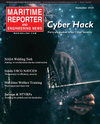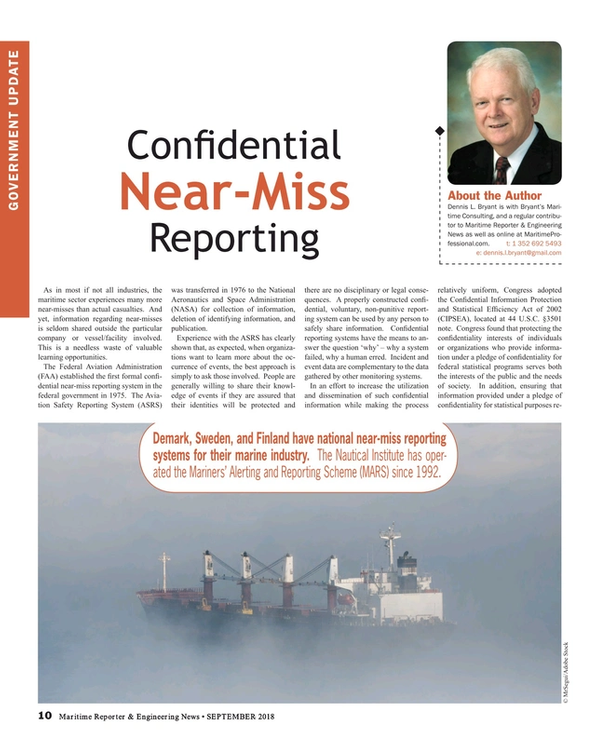
Maritime Accidents & Confidential near-miss Reporting
As in most if not all industries, the maritime sector experiences many more near-misses than actual casualties. And yet, information regarding near-misses is seldom shared outside the particular company or vessel/facility involved. This is a needless waste of valuable learning opportunities.
The Federal Aviation Administration (FAA) established the first formal confidential near-miss reporting system in the federal government in 1975. The Aviation Safety Reporting System (ASRS) was transferred in 1976 to the National Aeronautics and Space Administration (NASA) for collection of information, deletion of identifying information, and publication.
Experience with the ASRS has clearly shown that, as expected, when organizations want to learn more about the occurrence of events, the best approach is simply to ask those involved. People are generally willing to share their knowledge of events if they are assured that their identities will be protected and there are no disciplinary or legal consequences. A properly constructed confidential, voluntary, non-punitive reporting system can be used by any person to safely share information. Confidential reporting systems have the means to answer the question ‘why’ – why a system failed, why a human erred. Incident and event data are complementary to the data gathered by other monitoring systems.
In an effort to increase the utilization and dissemination of such confidential information while making the process relatively uniform, Congress adopted the Confidential Information Protection and Statistical Efficiency Act of 2002 (CIPSEA), located at 44 U.S.C. §3501 note. Congress found that protecting the confidentiality interests of individuals or organizations who provide information under a pledge of confidentiality for federal statistical programs serves both the interests of the public and the needs of society. In addition, ensuring that information provided under a pledge of confidentiality for statistical purposes receives protection is essential in continuing public cooperation in statistical programs. To that end, CIPSEA provides that an officer, employee, or agent of a federal agency acquiring information for exclusively statistical purposes who willfully discloses the information to a person or agency not entitled to receive it shall be guilty of a class E felony and imprisoned for not more than five years or fined not more than $250,000, or both.
The Office of Management and Budget (OMB) has published guidance to federal agencies on implementation of CIPSEA. Various federal agencies have since adopted programs under CIPSEA to collect, sanitize, and disseminate industry information relating to safety and related issues. Reports collected under CIPSEA are immune from legal process and may not be admitted into court. Those reports are also exempted from the Freedom of Information Act (FOIA). Information provided in such a report may not be disclosed in identifiable form for any non-statistical purpose without the informed consent of the provider of the information. The reports are submitted directly to the authorized statistical agency, not to the agency that established the program and ultimately utilizes the aggregated and sanitized information.
Numerous federal agencies now administer programs that utilize confidential reporting systems authorized by CIPSEA. These agencies include, among others, the Department of Agriculture, the Department of Justice, the Department of Energy, and the Social Security Administration. The Department of Energy alone utilizes the CIPSEA confidential reporting program in eleven separate industry survey programs.
The Bureau of Safety and Environmental Enforcement (BSEE) recently instituted its own confidential safety reporting system, called SafeOCS. Personnel in the offshore oil and gas industry may submit confidential safety reports to the Department of Transportation (DOT) Bureau of Transportation Statistics (BTS), which performs the confidentiality tasks for BSEE that NASA performs for the FAA.
The SafeOCS confidential reporting system collects and analyzes data to advance safety in oil and gas operations on the outer continental shelf (OCS). It facilitates the capture of essential information about accident precursors and potential hazards associated with offshore operations, including risks related to pipeline safety and offshore transport.
Almost all oil and gas companies operating on the OCS have internal safety data reporting programs. However, due to legal and commercial concerns, these data were not being shared widely among stakeholders. SafeOCS provides a solution to these concerns by offering operators and employees a confidential method to share important equipment failure and safety data. The aggregated data can be used to reduce the risk of major events, including loss of life or property and environmental harm.
Demark, Sweden, and Finland have national near-miss reporting systems for their marine industry. The Nautical Institute, an international group of maritime professionals headquartered in London, has operated the Mariners’ Alerting and Reporting Scheme (MARS) since 1992. Selected near-miss incidents are published in their monthly Seaways magazine. Since 2003, the UK’s Confidential Hazardous Incident Reporting Scheme (CHIRP) collects near-miss incident reports worldwide. It operates as a charitable trust and started out focused on the aviation sector. Findings and near-miss reports are published in the quarterly Feedback magazine.
In the early 1990s (prior to enactment of CIPSEA), the US Coast Guard attempted to institute a maritime near-miss reporting program similar to the FAA ASRS program for aviation. The attempt ran into a stone wall when the Department of Justice (DOJ) strongly objected. The DOJ position was that once the federal government acquired information of potential wrong-doing there should be no self-imposed limits on use of that information. They conceded that they had not been particularly vigilant when the FAA instituted its ASRS program, but they opposed any further spread of the concept. That initial USCG effort for a near-miss reporting program ended there.
Now, though, Congress has spoken and strongly supports this type effort. It is time for the Coast Guard, with the support of the maritime industry, to institute a maritime near-miss reporting program. For years it has worked for the FAA and the aviation industry. It now works for numerous other federal agencies. Confidential near-miss reporting will work for the benefit of the Coast Guard and the maritime industry, but only if there is the wide support to restart the process.
Read Maritime Accidents & Confidential near-miss Reporting in Pdf, Flash or Html5 edition of September 2018 Maritime Reporter
Other stories from September 2018 issue
Content
- Maritime Accidents & Confidential near-miss Reporting page: 10
- Port of San Juan: A Case Study in Port Security Innovation page: 12
- ECDIS & Maritime Accident Investigation page: 14
- Marine Low Sulphur Fuel: Organizing the Switch page: 18
- Maritime Welfare Training: More Important than Ever page: 20
- Mariner Training in Brazil: Inside the Institute of Nautical Sciences page: 28
- Maritime Ports Pushed to Up Cyber Security page: 32
- Maritime Industry's Slow Boat to Cyber Security page: 37
- NASA Welding Technologies Could Revolutionize Workboat Fabrication page: 42
- Maritime Response Services & Non-Tank Vessel Response Plans page: 48


